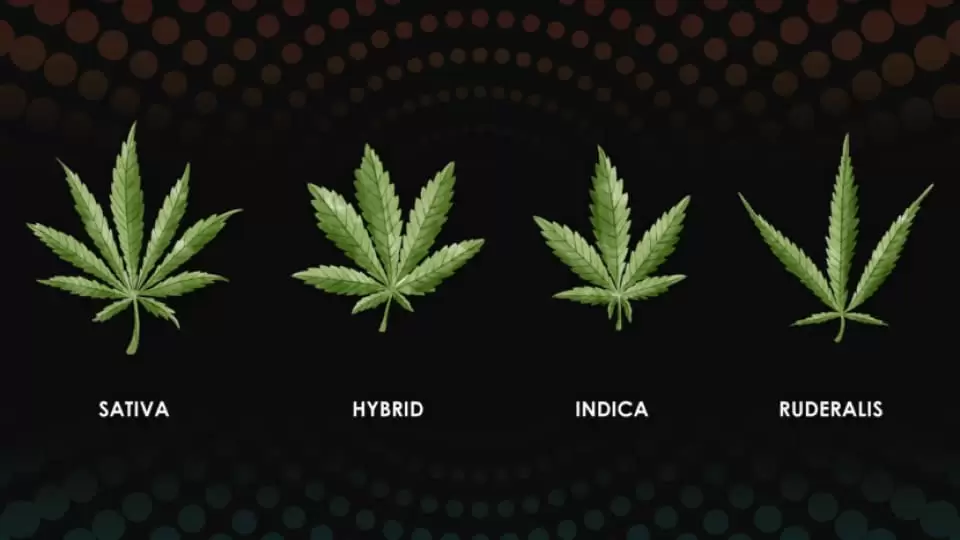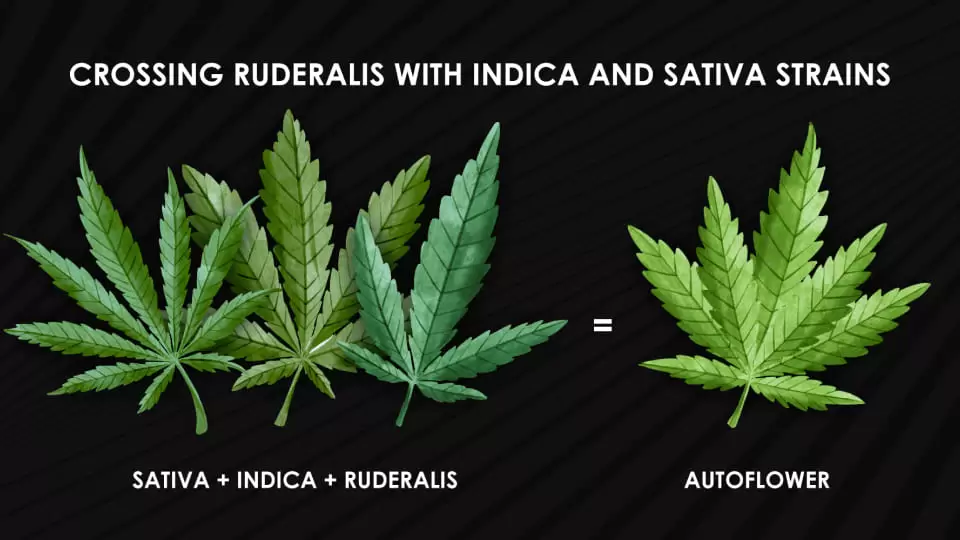Zkittlez

70% Indica
Compact Buds Coated in Sugar
Mouthwatering Fruit Candy
Powerful Nighttime High
Soothing Stress Relief

Navigating the vast world of cannabis, one quickly realizes that not all plants are created equal. When discussing the difference between Sativa, Indica, Hybrid, and Ruderalis, it’s clear that each brings its unique attributes to the table. These distinctions are more than just botanical classifications; they profoundly impact cultivation, effects, and medicinal applications. Understanding these differences is pivotal for growers, consumers, and enthusiasts alike, ensuring informed choices that best align with individual needs and preferences. In this guide, we’ll delve deep into what sets each type apart, providing insights that demystify the intricate tapestry of cannabis.
Cannabis, as a plant species, boasts a long, intertwined history with human civilization, dating back thousands of years. Let’s journey through time and trace the roots of these cannabis types.
Originating primarily from the equatorial regions of the world, like Southeast Asia, Central America, and Africa, Cannabis Sativa was among the first cannabis types to be discovered and utilized by ancient civilizations. Cultures across various continents tapped into Sativa’s versatile utility, using it for medicinal, industrial, and spiritual purposes.
The story of Indica traces back to the rugged terrains of Central Asia, particularly regions in today’s India, Pakistan, and surrounding areas. The harsh climate of this region gave birth to the compact and resinous Indica plants, which were utilized primarily for their medicinal properties and the production of hashish.
Often the lesser-known sibling in the cannabis family, Ruderalis finds its origins in the colder regions of Northern Europe and Russia. Unlike Sativa and Indica, Ruderalis wasn’t as popular historically for recreational or medicinal use due to its low THC content. Instead, its resilience and ability to flower automatically, irrespective of light cycles, made it an interesting subject for cultivation experiments.
As travel and trade expanded over centuries, the natural and deliberate crossbreeding of these distinct types gave birth to Hybrid strains. Growers began to experiment, aiming to capture the best qualities of Sativa, Indica, and Ruderalis in a single plant. This quest for the “perfect strain” led to the vast variety of hybrid cannabis varieties we see today, each designed to cater to specific tastes, effects, and cultivation challenges.
The world of cannabis presents a rich diversity, not just in effects and uses, but also in its physical form. To the trained eye, each type exhibits distinct characteristics that make them easily distinguishable. Let’s delve into the distinguishing features of each

These plants are the skyscrapers of the cannabis world. Sativa strains grow tall, often reaching heights of up to 12 feet (or even more in some cases). Their leaves are long, slender, and finger-like, with a light green hue. The buds of a Sativa plant are typically elongated and airy, with a fluffier structure than their Indica counterparts. This appearance is a direct adaptation to the warmer climates they hail from, allowing better airflow and reducing risks of mold and fungi.
In stark contrast to Sativa, Indica plants are the sturdy, compact warriors of the cannabis realm. They rarely grow above 6 feet, making them more suited for indoor cultivation. Their leaves are broader, almost paddle-like, and exhibit a deeper green shade. Indica buds are dense, chunky, and tightly packed, often resulting in a heavier yield than Sativa strains. This compactness is an adaptation to the cooler, often harsher climates of their origin.
As the name suggests, Hybrid strains are a blend of both Sativa and Indica genetics, and thus, their appearance can vary widely based on the dominant parentage. A Sativa-dominant hybrid might lean towards a taller growth with thinner leaves, while an Indica-dominant hybrid might display a shorter, bushier stature with broader leaves.
Often overlooked in the recreational world due to its minimal THC content, Ruderalis offers unique characteristics. These plants are the dwarfs among their peers, often not growing more than 2-3 feet tall. Their leaves are small, somewhere between the thinness of Sativa and the breadth of Indica. The buds are compact, similar to Indica, but usually smaller in size. Ruderalis plants are built for survival, having evolved to endure the shorter summers and colder climates of the northern regions.

Just as the appearance of cannabis plants differs based on their type, so too do their growth patterns. These patterns provide vital clues for cultivators aiming to maximize yield and optimize care. Here’s a closer look at the unique growth tendencies of each:
Sativa plants, native to regions near the equator, have adapted to longer, consistent periods of sunlight year-round. As a result, they often have extended flowering times, sometimes up to 10-12 weeks, or even longer. This longer cycle allows for the development of those signature long, fluffy buds. Their love for warmth means they thrive in sunny, equatorial climates and may struggle with shorter, cooler seasons. Growers in temperate zones often prefer indoor cultivation for Sativas to maintain control over the extended flowering period.
Tailored by nature for the variable climates of the Central Asian highlands, Indica strains generally have shorter flowering times, often between 7-9 weeks. This quick turnaround is an adaptation to regions where summers can be short, requiring the plant to complete its cycle before the cold sets in. Their bushy structure and dense buds also mean they are more resilient to colder temperatures, although they still prefer a consistent light pattern.
Hybrid strains, being a mix of Sativa and Indica genetics, can exhibit a wide range of growth patterns. Some might lean more towards their Sativa genetics, requiring longer flowering times, while others might display the rapid growth characteristics of Indicas. It’s vital for growers to research the specific hybrid strain’s needs, as their requirements can vary dramatically based on their parentage.
The true wildcard in the cannabis family, Ruderalis is unique in its growth pattern. Native to northern regions with long days in summer and extended darkness in winter, this plant has developed an autoflowering trait. This means that Ruderalis plants begin flowering based on their age, rather than the light cycle. Often, they start their flowering phase just 3-4 weeks after sprouting. This unique characteristic has made Ruderalis genetics highly sought after in breeding programs, leading to the creation of autoflowering Sativa and Indica strains that retain their high THC content while benefiting from the Ruderalis autoflowering trait.
| Feature/Type | Sativa | Indica | Hybrid | Ruderalis |
| Physical Appearance | Tall with thin leaves, airy buds | Short with broad leaves, dense buds | Varies based on parentage | Very short, small leaves, compact buds |
| Growth Pattern | Long flowering times, warm climates | Short flowering times, cooler climates | Varies, dependent on genetics | Autoflowering, not light-dependent |
| Effects | Uplifting, cerebral | Relaxing, body-centric | Can lean Sativa or Indica, depending on genetics | Minimal psychoactive effects |
| Typical Uses | Daytime use, creativity booster | Nighttime use, pain relief, relaxation | Varies, but often a balanced effect | Breeding for autoflowering trait |
| Origin | Equatorial regions | Central Asian highlands | Crossbreed of various strains | Northern Europe and Russia |
| Medicinal Uses | Depression, ADHD, mood disorders | Pain, insomnia, anxiety | Broad spectrum, depending on dominant traits | Autoflowering medical strains |
Cannabis has been cultivated and consumed for millennia, and one of its most alluring aspects is the diverse array of effects it can produce. Each type of cannabis plant offers a unique experience, tailored by nature and human cultivation to suit various needs and preferences.
Known for its energizing and uplifting effects, Sativa strains are often chosen by those looking to stimulate creativity, focus, and cerebral engagement. The high from a Sativa is predominantly head-centric. Many artists, writers, and creatives swear by Sativa strains to help them break through creative blocks or to fuel brainstorming sessions. Ideal for daytime use, a Sativa can invigorate the senses and promote a sense of well-being, making mundane tasks more enjoyable and social interactions more engaging.
If Sativa is the daylight of cannabis, Indica is the twilight. Indicas are known for their pronounced body effects. A typical Indica high is relaxing and calming, often leading to what’s affectionately termed as “couch-lock,” where the consumer feels pleasantly anchored to their spot. Perfect for evening use, Indica strains are often sought out for their therapeutic benefits, such as pain relief, muscle relaxation, and aiding sleep. Many medical patients opt for Indicas to alleviate chronic pain, anxiety, and insomnia.
Walking the middle ground are Hybrid strains, capturing the best of both worlds. The effects of a hybrid can be balanced, offering both cerebral stimulation and body relaxation. However, depending on their genetics, some hybrids may lean more towards Sativa or Indica. For example, a Sativa-dominant hybrid might evoke feelings of alertness but with a smoother, calming edge. On the other hand, an Indica-dominant hybrid might predominantly promote relaxation but with a touch of mental clarity. The diverse range of hybrids available ensures there’s a strain for every occasion and mood.
The often-overlooked member of the cannabis family, Ruderalis is not typically sought out for its effects. With naturally low THC content, Ruderalis doesn’t provide the potent psychoactive effects found in most Sativa and Indica strains. Instead, its value lies in its unique growth characteristics, particularly its autoflowering trait. This feature has made Ruderalis invaluable in breeding programs, leading to the development of autoflowering hybrid strains that combine the best of Sativa and Indica effects with the rapid growth of Ruderalis.
Whether you’re seeking inspiration, relaxation, a balanced mood, or rapid growth for cultivation, understanding the effects and uses of each cannabis type ensures you can find the perfect match for your needs.
For centuries, various cultures have recognized the therapeutic potential of cannabis and have used it for its healing properties. Modern research has begun to shed light on how different cannabis types can address a range of medical conditions. However, it’s vital to approach this topic with an informed and cautious mindset.
Disclaimer: The information provided in this section is for informational purposes only. It is not intended as medical advice and should not be considered a substitute for professional medical consultation, diagnosis, or treatment. Always consult with a qualified healthcare provider regarding any medical condition or treatment. Cannabis consumption for medicinal purposes should be undertaken under the guidance of a medical professional.
Predominantly known for its uplifting and cerebral effects, Sativa strains have been explored for their potential in treating mental and mood disorders. Some users and anecdotal reports suggest Sativa strains might be beneficial for conditions like depression, ADHD, and other mood disorders. The invigorating nature of Sativa strains could provide a mental lift, enhancing mood and promoting a more positive outlook.
With their calming and body-centric effects, Indica strains have been popular among patients seeking relief from physical ailments. Indicas are frequently suggested for conditions like insomnia, given their sedative properties. They might also offer relief for chronic pain and anxiety, promoting relaxation and potentially reducing discomfort.
Given their genetic diversity, Hybrid strains offer a broad spectrum of potential medicinal applications. Depending on their dominant traits, they can be tailored to address a combination of symptoms. For instance, a Sativa-dominant hybrid might help with mood enhancement while also addressing mild pain, whereas an Indica-dominant hybrid might be suitable for anxiety and muscle spasms.
While Ruderalis on its own isn’t typically used for medicinal purposes due to its low THC content, its genetics play a crucial role when combined with other types. Its autoflowering trait allows for the rapid cultivation of medical strains. When bred with high-THC or high-CBD strains, the result can be autoflowering medical cannabis that retains the therapeutic properties of Sativas or Indicas while benefiting from the swift growth pattern of Ruderalis.
The world of cannabis is vast, intricate, and deeply personalized. With so many strains and types available, the choices might seem overwhelming. However, by understanding your individual needs and preferences, and armed with the right knowledge, you can make informed decisions that enhance your cannabis experience.
Every cannabis consumer has a unique profile of preferences, tolerances, and desired outcomes. What works wonderfully for one person might not necessarily suit another. This is where strain research becomes paramount.
The cannabis plant’s two most prominent cannabinoids, THC (Tetrahydrocannabinol) and CBD (Cannabidiol) play pivotal roles in determining the effects of a strain.
Cannabis Ruderalis, once the lesser-known sibling in the cannabis family, has emerged as a vital player in the world of modern cannabis cultivation. Its unique characteristics and adaptability have made it a prized asset in breeding programs, revolutionizing the cultivation landscape in the process.

One of the standout traits of Ruderalis is its autoflowering nature. Unlike Sativa or Indica strains, which rely on specific light cycles to transition from the vegetative to the flowering stage, Ruderalis begins this transition based on its age, irrespective of the light it receives. This evolutionary adaptation, a result of its origins in the northern regions with inconsistent daylight hours, means Ruderalis plants can go from seed to harvest in a matter of weeks.
Recognizing this trait’s potential, breeders began to integrate Ruderalis genetics into popular Sativa and Indica strains, giving birth to the era of autoflowering hybrids. These new strains maintain much of the THC or CBD potency of their Sativa or Indica parentage but inherit the rapid growth cycle from the Ruderalis lineage.
In the evolving landscape of cannabis cultivation, Ruderalis has proven itself to be more than just a niche variant. Its contribution to modern breeding is undeniable, creating a new generation of cannabis strains that combine the best of all worlds – potency, speed, resilience, and diversity. As research and cultivation techniques advance, the role of Ruderalis in shaping the future of cannabis seems both promising and indispensable.
Navigating the diverse world of cannabis, we recognize the distinct attributes of Sativa, Indica, Hybrid, and Ruderalis. Sativa energizes and uplifts, while Indica soothes and relaxes. Hybrids meld these traits, tailored for varied effects. Ruderalis, the foundation of autoflowering breeds, revolutionizes cultivation with its unique growth patterns. As enthusiasts or patients, personal research remains crucial. Delving into strain specifics ensures an informed choice, allowing you to harness the ideal cannabis experience tailored to your needs. In this rich tapestry of choices, knowledge truly empowers.

Are you 21 or older?
You must verify that you are 21 years or older to enter this website. By proceeding, you are also agreeing to our terms and conditions, as well as consenting to the use of cookies on this site.